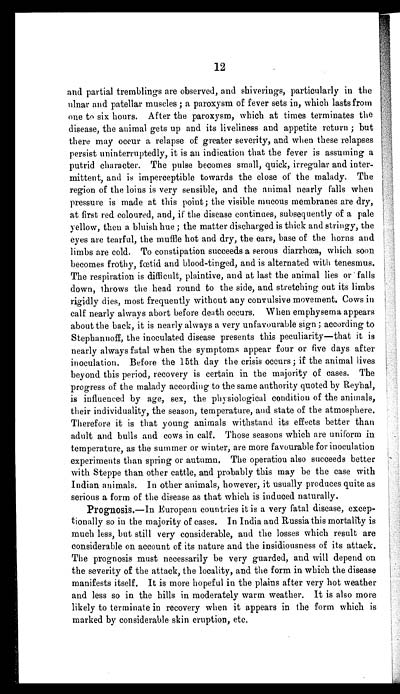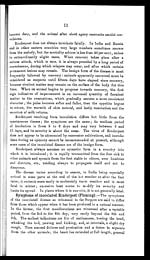Medicine - Veterinary > Civil Veterinary Departments > Civil Veterinary Department ledger series I-VI > Volume I - Rinderpest - cattle plague
(34) Page 12
Download files
Individual page:
Thumbnail gallery: Grid view | List view

12
and partial tremblings are observed, and shiverings, particularly in the
ulnar and patellar muscles; a paroxysm of fever sets in, which lasts from
one to six hours. After the paroxysm, which at times terminates the
disease, the animal gets up and its liveliness and appetite return ; but
there may occur a relapse of greater severity, and when these relapses
persist uninterruptedly, it is an indication that the fever is assuming a
putrid character. The pulse becomes small, quick, irregular and inter-
mittent, and is imperceptible towards the close of the malady. The
region of the loins is very sensible, and the animal nearly falls when
pressure is made at this point; the visible mucous membranes are dry,
at first red coloured, and, if the disease continues, subsequently of a pale
yellow, then a bluish hue ; the matter discharged is thick and stringy, the
eyes are tearful, the muffle hot and dry, the ears, base of the horns and
limbs are cold. To constipation succeeds a serous diarrhœa, which soon
becomes frothy, fœtid and blood-tinged, and is alternated with tenesmus.
The respiration is difficult, plaintive, and at last the animal lies or falls
down, throws the head round to the side, and stretching out its limbs
rigidly dies, most frequently without any convulsive movement. Cows in
calf nearly always abort before death occurs. When emphysema appears
about the back, it is nearly always a very unfavourable sign ; according to
Stephannoff, the inoculated disease presents this peculiarity—that it is
nearly always fatal when the symptoms appear four or five days after
inoculation. Before the 15th day the crisis occurs ; if the animal lives
beyond this period, recovery is certain in the majority of cases. The
progress of the malady according to the same authority quoted by Reyhal,
is influenced by age, sex, the physiological condition of the animals,
their individuality, the season, temperature, and state of the atmosphere.
Therefore it is that young animals withstand its effects better than
adult and bulls and cows in calf. Those seasons which are uniform in
temperature, as the summer or winter, are more favourable for inoculation
experiments than spring or autumn. The operation also succeeds better
with Steppe than other cattle, and probably this may be the case with
Indian animals. In other animals, however, it usually produces quite as
serious a form of the disease as that which is induced naturally.
Prognosis.—In European countries it is a very fatal disease, excep-
tionally so in the majority of cases. In India and Russia this mortality is
much less, but still very considerable, and the losses which result are
considerable on account of its nature and the insidiousness of its attack.
The prognosis must necessarily be very guarded, and will depend on
the severity of the attack, the locality, and the form in which the disease
manifests itself. It is more hopeful in the plains after very hot weather
and less so in the hills in moderately warm weather. It is also more
likely to terminate in recovery when it appears in the form which is
marked by considerable skin eruption, etc.
Set display mode to: Large image | Zoom image | Transcription
Images and transcriptions on this page, including medium image downloads, may be used under the Creative Commons Attribution 4.0 International Licence unless otherwise stated. ![]()
| India Papers > Medicine - Veterinary > Civil Veterinary Departments > Civil Veterinary Department ledger series I-VI > Rinderpest - cattle plague > (34) Page 12 |
|---|
| Permanent URL | https://digital.nls.uk/75515866 |
|---|




